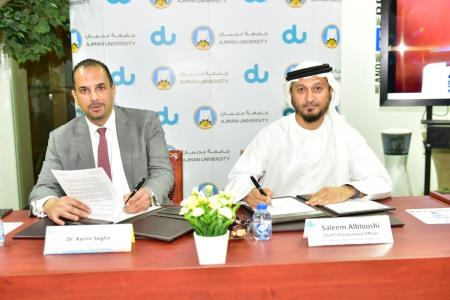


du and Ajman University (AU) signed a Memorandum of Understanding (MoU) to further collaborate on 5G and Internet of Things (IoT) development as part of the UAE 5G Innovation Gate (U5GIG). The lab is officially inaugurated and can be accessed by U5GIG partners and universities to develop, test and customise IoT, 5G, and Artificial Intelligence use cases. The MoU was signed by Saleem AlBlooshi, Chief Infrastructure Officer, EITC, and Dr. Karim Seghir, Chancellor, Ajman University at Ajman University Innovation Centre in the presence of other senior officials.
U5GIG has been envisioned to be a consortium of industrial and academic organisations in the UAE, supported by international telecom organisations, to plan and use their expertise to define and develop a global 5G network that will radically change lives by building a super-connected nation.
In line with the MoU, Ajman University staff and students will have access to U5GIG and conduct research on evolving use cases related to 5G; in addition, du will offer an internship program for AU students. Moreover, du and AU agreed to publish technical research papers and other relevant cases studies to showcase the latest innovations of 5G and the IoT ecosystem.
Saleem AlBlooshi, Chief Infrastructure Officer, Emirates Integrated Telecommunications Company (EITC), said: “We welcome Ajman University to U5GIG. It is heartening to see U5GIG grow from a concept stage to a full-fledged consortium of like-minded partners from academia and global names in technology. The future is of 5G is in effectively leveraging Internet of Things and our U5GIG is fully equipped to bring to life the latest use cases in IoT.
Speaking on the occasion, Dr. Karim Seghir, Chancellor, Ajman University, said: “U5GIG is a pioneering technological effort from du and we are delighted to join this initiative. This is an excellent opportunity for our students to contribute to nation-building and we believe this type of collaborative effort with bright young minds will lead to acceleration in the eventual roll-out of 5G and other futuristic technologies.”
The U5GIG Lab – launched in 2016 by du – continues to grow in stature and attract support of major technology powerhouses and major centres of academic excellence. In addition to Ajman University, the lab consortium consists of academic partners including Dubai University, Rochester Institute of Technology Dubai, Sharjah University, American University of Sharjah, University of Ras Al Khaimah and University of Wollongong in Dubai, as well as technology partners Libelium, SAP Software Solutions, Vision Valley, Intel, Nokia, MediaTek, Hal Technology and Schneider Electric. This consortium continues to work together, using their expertise to define and develop a global 5G network that will positively impact life in the UAE.
Use Cases Projects by U5GIG
Smart parking – This use case aims to address the global issue of traffic congestion, and particularly the contribution of parking to this issue. Searching for a parking space is not only frustrating, it increases the carbon footprint of each individual as it burns one million gallons of oil every day. The implementation of smart parking could accurately predict and sense vehicle occupancy in real time, thereby optimising parking space usage. This would simplify the parking experience for commuters, drivers and merchants, while simultaneously enabling the monitoring and management of parking for improved revenue generation. According to a report, properly implemented smart parking sensors could result in 2.2 million gallons of fuel saving until 2030 and 3 million gallons of fuels saved by 2050.
Smart Agriculture – The implementation of smart agriculture could radically transform the industry by giving warnings and offering predictions about agriculture events which could be useful for optimising crop yields. Additionally, smart agriculture could bring about the gathering of data for use in creating prediction models regarding adverse conditions. Moreover, farmers could use the sensors to reduce water use by up to 30% after planting and 15% during the harvest.
Smart Water – The implementation of sensors for water monitoring has the potential to bring about a variety of benefits. Smart Water is suitable for potable water monitoring, chemical leakage detection in rivers, remote measurement of swimming pools and spas, and levels of seawater pollution. The water quality parameters measured include pH, dissolved oxygen (DO), oxidation-reduction potential (ORP), temperature and dissolved ions.
Energy Monitoring – This use case demonstrates the way that Energy Monitoring benefits utilities by improving customer satisfaction with faster interaction, while giving consumers more control of their energy usage to save money and reduce carbon emissions. Benefits include reduced operating expenses by managing manual operations remotely, as well as improved forecasting and streamlined power-consumption among others.
Smart Environment – While a clean air supply is essential to our health and that of the environment, since the industrial revolution, the quality of the air we breathe has deteriorated considerably. The issue of air quality is still a major concern for every citizens, and Smart Environment enables us to monitor the air quality, and work towards improving by controlling emissions of harmful substances into the atmosphere, improving fuel quality, and by integrating environmental protection requirements into the transport and energy sectors.
Smart City – Noise pollution from air and road traffic, industry, and construction is a prime factor that affects and harms citizens. Monitoring environmental sound levels in cities and urban environments is an important issue. Lighting applications allow municipalities to save money and energy by dimming lights during low traffic hours, and to enhance security by lighting dark areas when people are present.
LiFi – High-speed green Wireless communication without RF. Providing wireless communication for sensitive locations where the RF communication is risky to be used (i.e., emergency rooms, airplanes, etc..….). Achieving a very high throughput while aggregated with the WiFi network. LiFi can be used in Geo-location & Geo-marketing, Video & Music streaming and Tagging for corporate assets.
Copyright © 2025 IOT Online Store. All Rights Reserved. | Another Cyber Gear Site.